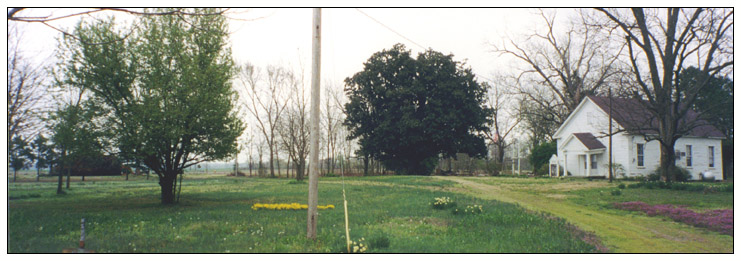

| The oldest settlement (c. 1850) in central Woodruff County. A brief, early history of DeView can be found in "De View -- McCrory" by Dorothy W. Bronte in Rivers and Roads and Points in Between, Vol. 1, No. 1 (Augusta: Woodruff County Historical Society, Fall 1972) p. 14: | ||
| The date that DeView first was settled
is uncertain. Legend has it that the French cleared the land and gave the
village its unusual name. The country for miles around, including what later
was to be McCrory, then was a vast wilderness. Eventually, the stagecoach line ran through DeView, which contributed to its growth. The nearest railroad was built through Brinkly to Colona and to Grays, west of DeView. More widely used was the water route over White River at Augusta... The entire area from DeView to the Jackson County line, many miles north, (including the land where McCrory later was to be) was known as "Jennie's Colony." Old-timers around McCrory, who have been gone for many years, spoke of "Jennie's Colony" as the stretch of land from DeView to the Jackson County line; but who "Jennie" was, or how the name happened to be established, is not known. A few descendants of DeView's early settlers still reside there. Mr. and Mrs. "Pete" McMurtry still live in the house, surely one of the oldest in the country, where his mother, Adeline Ritledge, an orphan from Mississippi, was living with the "Betsy" Crossett family in the 1860's when her future husband, William Henry McMurtry, moved to DeView with his parents from Louisiana. Mr. Crossett was a partner in the Crossett and Scales store at DeView. Mrs. Robert Wright, the former Marietta Stark, is the granddaughter of A. R. Stark, who was born in Virginia in 1832 and came to DeView in 1857 to teach school, making the trip by boat to Augusta, where he landed on New Year's Day. His son, Gideon Stark (Mrs. Wright's father) erected a store building and operated a grocery and general merchandise store there. Gideon Stark's wife, Salina Angeline Brown, moved to DeView from Tennessee in 1860, when she was three. Mrs. Stark died in 1949, and the age of 92. After Gideon Stark's death in 1915, his son, Tad Stark, continued to operate the store for several years; but the old store building, last of DeView's "business houses," finally was razed in 1951. Both Mrs. Wright and her son, Bobby Wright, live near the site of the old store building. The historic old DeView schoolhouse was razed the year before the Starks store. Erected about 1870 by a man named Nesbitt, at first it was a two-story structure, with the second floor used for the Masonic Lodge. Since DeView was the only community in this part of the country, the school, well-equipped for those days, was known for many miles. From as far away as Tupelo, in Jackson County, people sent their children to board with families there while attending the "academy." The history of DeView is filled with random names and dates, about which, generally, little else is known. Mr. and Mrs. Marion Johnson, grandparents of Mrs. John Crossett and Mrs. Grover Earley of McCrory, were married at DeView in 1889 by Dr. Moses Henry McMurtry. Mrs. W. B. Daugherty, who lived in McCrory until her death many years ago, came to DeView with her parents from Tennessee in 1855. Mr. and Mrs. James Robert Crossett were married at the DeView Methodist Church in 1887 by a Reverend Mr. Morris, the pastor. Judge J. T. Angelo, who was a justice of the peace, a DeView School director for 30 years, and finally a county judge in 1911, 1912, 1913 and 1914, was born near DeView in 1864. Elias Huff settled farm land northeast of DeView in the early 1850's, land which has been occupied by the Huff families ever since... Dr. E. O. Grigsby came from Mississippi to DeView in 1867, practicing medicine and later establishing a drug store there. During the Civil War he had served as an assistant surgeon in the 10th Mississippi Regiment and as a surgeon in the 7th Alabama Cavalry under Captain Colvin. Columbus M. Crossett, who was born at Hernando, Miss., in 1849, moved with his parents to Cotton Plant in January, 1854, when one small grocery store was the only indication that a town might exist there later. Three years later, the family moved to Bullville, south of DeView, and afterwards moved to DeView. One of DeView's most portentous homes in its early days probably was the old Crossett house, part of which still stood, until a few years ago, like a lonely sentinel in a cotton field north of DeView. Columbus Crossett's daughter, Mrs. Louis Best... recalled before her death in 1952, that she grew up in the house. "Dr. W. H. McMurtry built the house before the Civil War," Mrs. Best related, "First he built a log house, then later a frame house and connected the two with a closed hall in the center. There was a small front porch across the hall. "I was so young then, I can't recall whether Papa bought the house from Dr. McMurtry or from someone else. There were still a lot of negro quarters around the house when we moved there. It was a wonderful place for a child. The house had such large rooms, and we had fun sliding down the balustrade in the hall. There was a peach orchard and a plum thicket to play in. "I remember Mr. Stark's store, the Shearer store, Mr. Albert Thompson's store, Lewis Winfrey's drug store, and the blacksmith shop," Mrs. Best concluded. Dr. J. W. Morris, who was 97 years old February 6 [1972], and who still goes to his office in McCrory every day and who goes fishing occasionally when the weather permits, came to DeView to practice medicine April 17, 1900. He recalls that , then, there were only two general stores, the Stark store and one across the street to the north owned and operated by Albert Thompson, who also owned a drug store operated by Lewis Winfrey. Dr. Morris, who had just graduated from the Medical School of the University of Nashville... bought the practice of Dr. Pumpkin at DeView (Dr. Grigsby died about 1900)... After the coming of the Missouri Pacific railroad two miles north of DeView, and McCrory's birth and subsequent growth, there was a gradual exodus from DeView. In 1910, the second story of the school house was removed. In 1930, the school board voted to consolidate with McCrory, and to give the school building to the DeView Home Demonstration Club and the S. O. L. Club, an organization of DeView men. In May, 1933, the Arkansas Democrat carried a news item reading: "The old schoolhouse, which witnessed DeView's era of prosperity and its later lapse into an almost-deserted village, is being transformed into a clubhouse in its new location on the site of the old cotton gin which was torn down recently." In January, 1950, the old building, unused for three years, was purchased by Ed Bone and razed. The money from the sale went for the support of the DeView Methodist Church and Sunday School. The old church building fared a better fate. Erected in 1863, of cypress brought by ox-wagon from Augusta, where it had arrived by boat, it was sill in use in 1941. DeView residents decided to tear it down and rebuild a new church with the same lumber. Since the new building was made narrower -- little new lumber was necessary... |
||
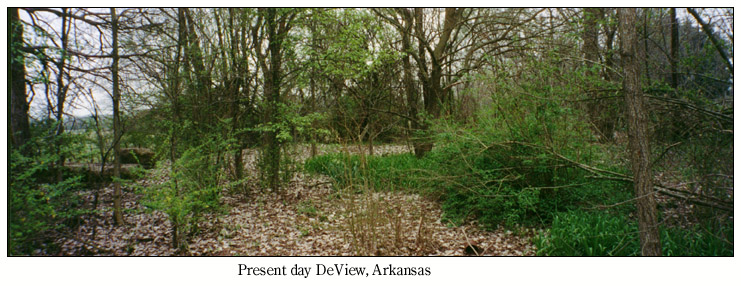 |
| From "The Methodist Church at DeView" by Mrs. Roger Burkett in Rivers and Roads and Points in Between, Vol. XVI (McCrory, 1989), pp. 51-56: | ||
| The DeView Methodist Church is the
second church to set by the side of a huge century old Magnolia tree just off
Highway 145 South, two miles south of McCrory, right in the heart of DeView.
The first Church organized in 1863 was built from cypress lumber brought to
DeView by Ox team from Augusta, where it had made its way down the White River.
At that time DeView was a thriving little town of several businesses, including
three drug stores, two blacksmith shops, mercantile store, three physicians,
and the only school and church in central Woodruff County. The little white
frame church is all that is left now. To the east of the Church is the
parsonage occupied now by A. G. Cobb. It hasn't been used for a parsonage since
1957 when Rev. Orvie Stahl was the last pastor to live in it. To the west are Bobby Wright and Jane Wright Price's houses, great great grandson and great great granddaughter of A. R. Stark, who came to DeView in 1857. Across the road is the old Albert Thompson House, now the home of Emma Zigler and Maxine and Carl Zigler. Down the road a little ways is Roger Burkett's house setting where his great great grandparents Eli and Roseanna Burkett built their home in 1869. The present church is built from the well preserved lumber from the old church. In 1941 a building committee composed of E. M. Weld, J. G. Wilson, Ned McMurtry, Lee Douglas, and Ted Stark and the pastor Rev. W. M. Womack, assisted by Rev. A. N. Storey, a former pastor, planned the new building, making it eight feet shorter than the old one but adding electric light fixtures to replace the old carbide lights that hung from the high ceilings of the first church. Woodheaters were still used to heat the new building and air conditioning was by opening the windows on each side of the Church. The woodheaters were replaced in 1959 with gas heaters. Air conditioners were added in 1978. In 1980 the sanctuary was carpeted and a bath was installed, making it today a modern and comfortable church in which to worship. Little history of the first 22 years of the Church is know. Helen Raney, church secretary, has a church record book dated 1884 to 1907 and the first name appearing on the list of members is Martha Crossett. She was the daughter of Mose Henry and Parthenia McMurtry who had moved to Woodruff County in 1855. On down the list of names who are known to be earlier settlers are Roseanna Burkett, G. E. Wells, Henry Barber, James J. Thompson, Gideon Stark, Minnie B. Burkett, Albert Thompson, Addie McMurtry, W. H. McMurtry, Callie Wright; and the list goes on and on. These were on the Church roll during 1884 thru 1887. During the 1890's and the early 1900's Dr. J. W. Morris's name was added as well as Rebecca Haggard, Ermma Sturdivant, and children of the ones named above as well as other new families moving into the community, making a total of 164 members on the roll by 1907. The last name recorded on this register was Marietta Stark, baptized May 19, 1907. "Miss Marietta," who later became Mrs. Robert Wright, remained a faithful member until her death February 19, 1977. She was church pianist for over 60 years and served as church treasurer for many years. "Marietta" as she was affectionately known was given a special recognition at the 1966 homecoming. Bro. Ed Henderson, former pastor, paid special tribute to her and in referring to her said, "Marietta is the Methodist Church in DeView." he added that he had never known a more dedicated church member. She was referred to also as the living spirit of DeView which has held the people together these many years. Her son Bobby Wright and family are still active members of the Church... |
||
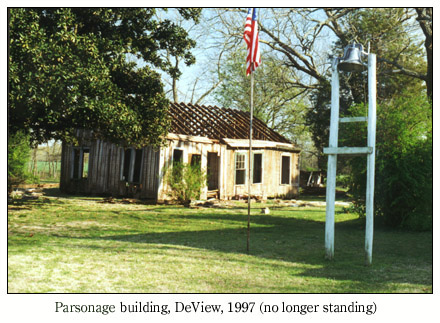 |
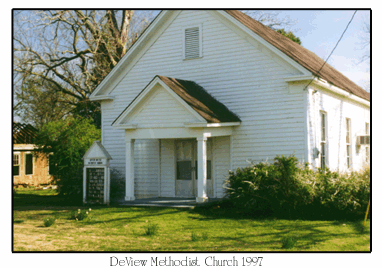 |
| Arkansas State Gazetteer and Business Directory, Volume 1, 1884-5 (St. Louis, MO: R. L. Polk & Co. copied in Rivers and Roads and Points in Between, Vol. VIII, No. 4 (Fall, 1980), p. 31: | ||
| DeVIEW. A post village in township of
same name, Woodruff county, 93 miles northeast of Little Rock, 13 miles
southeast of Augusta, the county seat, and 3 miles northeast of Colona, the
nearest railroad station. Newport is the nearest banking point. It contains 2
churches, a district school and 4 steam cotton gins and corn mills. Cotton,
hides, furs and livestock are shipped. Stages daily to Colona. Population, 200.
Tel., W. U. Express, Southern. Edward Scales postmaster. Wm. Bowers, shoemaker; Drew Burkett, coffins and farm implement; Eli Burkett, buggy and wagon factory; John Burkett, general store; E. J. Crossett, justice of the peace; R. B. Crossett, druggist; Crossett & Scales, general store; Dr. G. B. Fakes, cotton gin and corn mills; Henry Folsom, constable; M. W. Folsom, justice of the peace; Gray & Argus, cotton gin and corn mills; Dr. E. O. Grigsby, druggist; J. Hightower, physician; Wm. Matthews, horseshoer; Ed Scales, general store; Dr. James Scales, cotton gin and corn mill; Mrs. H. E. Shearer, sewing machine agent; John Shearer, general store; Charles Shertavent, cotton gin and corn mills; Zack Ward, blacksmith; Louis Wells, cotton gin and corn mills. |
||
In Volume XXI (1994), of the Rivers and Roads and Points in Between, there is published (on page 11) a block and lot survey for the "Town of DeView" done by W. R. Crossett on January 1, 1867. The map is not done to scale nor are there any references of where it is exactly located. One wonders if the town actually followed this layout, and their appears to be some differences between this survey and the way the streets and blocks are described in W. H. H. Holland's 9 Dec 1887 deed (Woodruff County Deeds, Book J Page 594), where Church Street is not mentioned being between Tupelo and Main Street.
| DeView layout derived from the 1867, W. R. Crossett survey: | ||
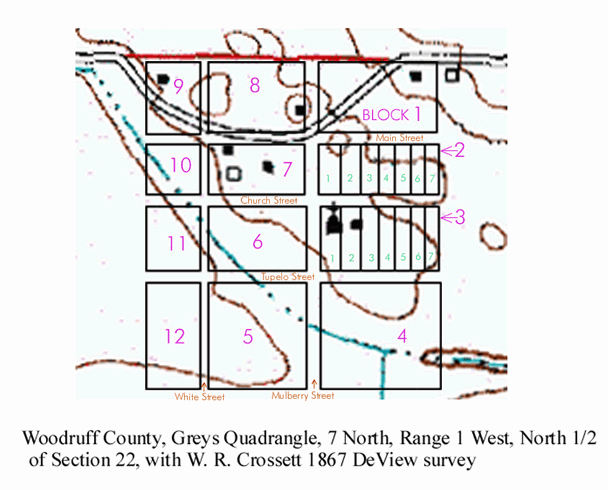 |
||
A map for some building and "street" locations between 1916 and 1935 for DeView which was dictated to Bobby Wright (the present caretaker of the DeView Church) from an old inhabitant of the area, can be found in Rivers and Roads and Points in Between, Vol. XXV (1998), p. 35.
![]()
This page created on 05/14/00 15:11. Updated 11/10/2000 14:51.